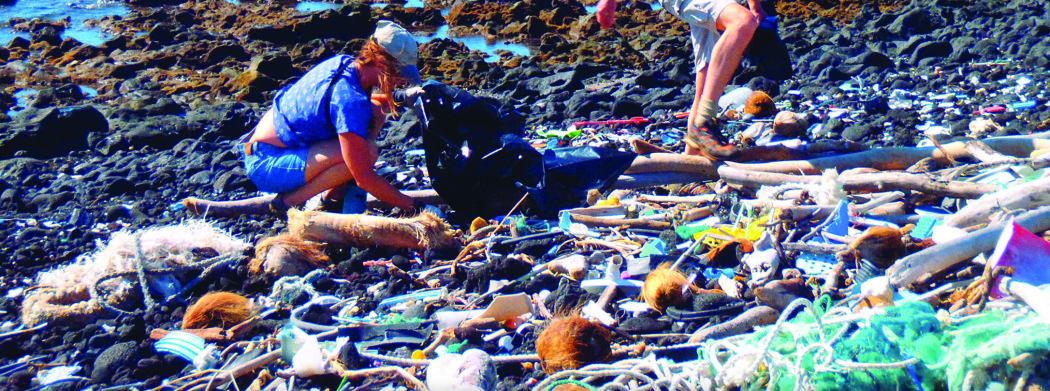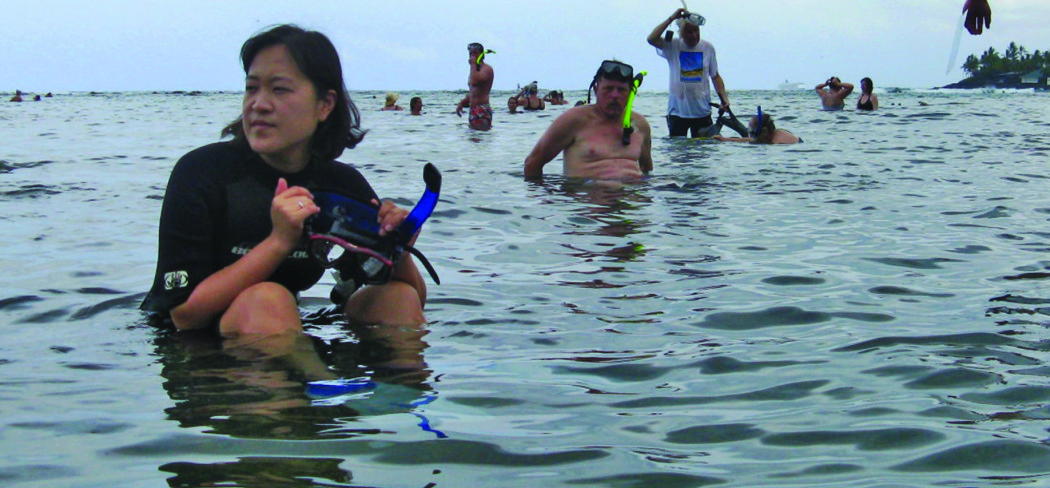
Clean-Up Crusaders: Volunteer Groups Turn Out to Keep Hawai‘i Island’s Shorelines Beautiful
 By Noel Morata
By Noel Morata
It’s 8:30 on a stormy, drizzly morning at the lighthouse facing Hilo Bay. Assembled is a group of very dedicated people from the Hawai‘i Wildlife Fund, the Surfrider Foundation and members of Mālama Kaipalaoa. Even the hair stylists from Headline News came down before their salon opens to help clean up the Bayfront this morning.
The cleanup work is being coordinated by Megan Lamson of Hawai‘i Wildlife Fund (HWF). She has been working tirelessly all around the island with many volunteer groups to help clean up the ‘āina, including Hilo Bay. Here, Mālama Kaipalaoa is a volunteer group that caretakes the small, grassy area around the lighthouse on this tiny spit of land called Kaipalaoa Landing, a gathering spot for mostly surfers and fishermen. Eventually, they want to develop this area as a park and cooperate with a future project connecting the entire Hilo Bayfront with walkways, greenbelts and family picnic areas.
Some of the regular volunteers attending this morning are members of the local Surfrider chapter, a nonprofit group that is focused on preserving the ocean, its waves and beaches through various educational and group-sponsored initiatives. This includes regular beach, bay and oceanfront cleanup days on the east side of the island.
The Hilo chapter coordinator, James Kuriyama, encourages the members, along with the public, to come out and help with regular beach cleanups. Even his mother, Kathy, a lawyer visiting from Washington was enthusiastic about pitching in. “This isn’t bad at all,” says Kathy, an active volunteer in many cleanup projects in her own area.
“First you have to love yourself and your community; anything small kine helps, even picking up a little garbage like today’s event,” says Nadine Robertson, a dedicated and regular volunteer for both Surfrider and Hawai‘i Wildlife Fund. Nadine is the type of person that typically acts instead of talking about helping out. She and her husband Mark, both wearing Surfrider blue t-shirts and toting bright orange Wildlife Fund buckets, have been involved in many cleanup projects.
The Kona chapter members are also active with cleanup programs, including the joint International Surfing Day cleanup day done in June. Most often they carry out cleanups in the Ka‘ū district, where there is an ongoing struggle keeping up with the ocean debris that is increasingly washing up onto the coastline by ocean currents that converge there.
The Hawai‘i Wildlife Fund typically coordinates anywhere from six to 12 events annually and has collaborated with other state and local organizations to start beach cleanup programs in various locations around the island. One of the first was with the Natural Area Reserve crew (managed by the state Dept. of Land and Natural Resources, Division of Forestry and Wildlife) They concentrated in the area around South Kona, primarily around Manukā Bay, where they do an annual cleanup with some 40-plus volunteers coming to clean the rugged coastline around this bay.
An area notorious for its garbage is along the coastline in Ka‘ū: Kamilo Point. The garbage isn’t generated locally, it comes from across the Pacific. Due to ocean currents and wind patterns, a confluence of garbage floating from the West Coast of the mainland and many Asian countries, is carried and dumped onto our shores. The southeast shoreline of Hawai‘i Island annually collects about 15-20 tons of plastic, glass and fishing nets.
When the first cleanup day was organized by the Hawai‘i Wildlife Fund in 2003, more than 75 volunteers showed up that weekend to collect a whopping 50 tons of trash at Kamilo Point. “This project has increased public awareness about the marine debris in Ka‘ū, and galvanized help and support for ongoing cleanups in the area”, says Megan. The next cleanup is scheduled for July 14. [See sidebar for contact info.]
Not all cleanup projects are centered on marine and coastline areas; there are other programs that focus on neglected, trashed or illegal dumping areas inland. Recycle Hawai‘i is a non-profit organization that has been in operation and celebrating 20 years of recycling programs on Hawai‘i Island. Outside of educating the public about recycling, Recycle Hawai‘i also helps to organize and support various groups cleaning up illegal dump sites.
Local community groups in Fern Acres and Hawaiian Beaches, ‘O Ka’u Kakou and Hui Aloha Kiholo have cleaned up trash and illegal dump sites in their communities, making positive changes to their ‘āina. Grants to Recycle Hawai‘i such as a recent $10,000 grant given by the county prosecuting attorney’s office, have enabled cleanup programs of illegal dump sites, including those in lava tubes in the Ka‘ū district. Expenses covered include gas for volunteers and meals, transportation of garbage, staging and transfer, along with various items like gloves, garbage bags and reflective vests.
Private enterprises that fund cleanup projects in conjunction with Recycle Hawai‘i, include the Matson grant Ka Ipu ‘Āina (container for the land). Matson provides $1,000 per dump cleanup and free 40-foot containers for hauling to groups applying for this grant. Recycle Hawai‘i helps with the application process for groups that do not have non-profit status and want to apply for the grant.
It is very encouraging that individuals can also make a big difference, connecting and organizing cleanup projects within their community. Jeff Fear is one of those individuals and his group, Big Island Wave Riders Against Drugs, have been doing coastal cleanups for over 19 years. Jeff initially started educating kids from the local surf clubs about drugs. Then he expanded to educating kids about trash and cleaning up the areas they surf in. Collaborating with Hawai‘i Island Surfing Association and the Betty Kanuha Foundation, they have increased West Hawai‘i coast cleanups from 10 to 11 times annually.
Jeff is more vigilant about the beach cleanups, noting that in the next year, more of the garbage floating just off the shore of Hawai‘i Island will be landing along Hawai‘i’s coastlines. “Being a fisherman and seeing all the garbage way out in the ocean, I would love to see a trawler sweeping garbage up from the ocean before it reaches our coastline and creates more problems for us,” says Jeff. He is optimistic that more people will see the cleanup programs as crucial to our economy and personal use, and they will help his group or others to clean up the coastlines.
In the Puako area, Cynthia Ho, the coordinator for Keep Puako Beautiful, organized one of the biggest cleanups in her area by “pole 75,” an illegal dump site that was an on-going eyesore to the area. She organized 44 volunteers and free trash containers and hauling to clean up over 62 tons of trash at this site, an equivalent of over 28 truckloads of trash. From that major cleanup, Cynthia has galvanized her community to continue regular cleanups and has an active email database. It’s an on-going battle, and she continues to coordinate projects at least three times annually in various sites around the Puako area.
The biggest cleanup program on the island, known as “Get the Drift and Bag It,” is part of the International Coastal Cleanup program started by the Ocean Conservancy. Over 27 years of collecting and documenting garbage on the islands have been accomplished through this one-day event.
“Anything on the road also has the potential for reaching the ocean, and trash can easily cover many inaccessible areas of our island,” says island coordinator Terry Miura. Last year, more than 650 people on Hawai‘i Island collected over 6,700 pounds of garbage, and more than 9,000 cigarette butts alone were picked up that day.
This year’s cleanup is scheduled for September 15, and they are hoping for more volunteers to help. ❖
Contact writer Noel Morata: emorata@yahoo.com


